Early on, the basilica built at Agaune became venerated and honoured through gifts of decorative art made of gold, silver and glass.
“We often hear, do we not, that a particular locality or city is held in high honour because of one single martyr who died there; and quite rightly, because in each case the saint gave his precious soul to the most high God. How much more should this sacred place, Aguanum, be reverenced, where so many thousands of martyrs have been slain, with the sword, for the sake of Christ!’
(From: Eucherius, Letter to Bishop Salvius, a presbyter from Marseilles ca 434 – 50 AD).
As reported by Eucherius, Aguanum was very early on gifted with precious pieces of art made of gold and silver. Since then, the monastery (later Abbey) has cared for a singularly impressive treasure consisting of precious vases, reliquaries, chests and textiles (found wrapped around the relics). Some of these may indeed be dated to Late Antiquity and witness to the writings of Eucherius.
Highlights from the Early Middle Ages:
The Vase of St. Martin of Tours
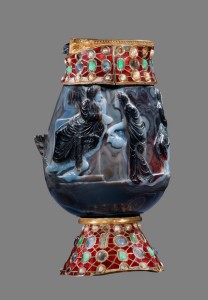 The vase made of sardonyx is from the 1st century BC. Sometine, probably at the end of the 5th century it was mounted with a golden foot or base and neck, decorated with silver spangles, garnets, pearls, emeralds and sapphires. According to legend the vase was gifted by St. Martin, when he passed through Aquanum on his way to Gaul. However, the mounting of the vase probably dates to the reign of Sigismund, and it has been thought that it might even be a gift from him to “his” new abbey.
The vase made of sardonyx is from the 1st century BC. Sometine, probably at the end of the 5th century it was mounted with a golden foot or base and neck, decorated with silver spangles, garnets, pearls, emeralds and sapphires. According to legend the vase was gifted by St. Martin, when he passed through Aquanum on his way to Gaul. However, the mounting of the vase probably dates to the reign of Sigismund, and it has been thought that it might even be a gift from him to “his” new abbey.
However, in a recent study Pierre Alain Mariaux these myths were found to have been concocted in the middle of the 12th century as part of a reorganisation of the memorial of the abbey. “By calling on founders from the distant past, the abbey could acquire a longer history and so carry on as a sacred site, writes the art-historian..
( Objet de Trésor et mémoire projective: Le vase “de saint Martin”, onques faict par mains d’omme terrien. By Pierre Alain Mariaux,. In: Le Moyen Age. Revue d’histoire et de philologie 2008, Vol. 114/1 pp. 37 -53)
The Reliquary of Theuderic
 The small reliquary in the form of a sarcophagus is made of gilded silver, embellished with cloisonné and a profuse splatter of antique seals. In the center is a seventh-century copy of an antique cameo. It measures 12.7 cm in the height.
The small reliquary in the form of a sarcophagus is made of gilded silver, embellished with cloisonné and a profuse splatter of antique seals. In the center is a seventh-century copy of an antique cameo. It measures 12.7 cm in the height.
On the back is an inscription: teuderigus presbiter in honore s[an]ct[t] Mauricii fieri iussit. Amen. Nordolaus et Rihlindis ordenarunt fabrigare Undiho et Ello ficerunt. Made in Southern Germany in the 7th century
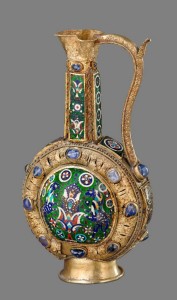 The Ewer of Charlemagne
The Ewer of Charlemagne
The provenience of this ewer has been heavily contested. Is it of oriental provenience and from the 9th century? Is it an occidental piece of art inspires by an Iranian original? Is it a mixture of Byzantine and Oriental workmanship? On problem is that it is almost certainly made of composite parts from different traditions and of varying age.
The ewer measures 30.3 cm in height. Its body is formed of two convex disks, enamelled and each framed by borders. It stands on a plain, tapering foot of a later date.
It is believed now to have been made from Byzantine enamelled plaques from the second half of the 9th century. Some art-historians consider the ewer the result of rather common Byzantine workmanship.
The legend is that the ewer was a gift from Charlemagne. Another theory is that it was a gift from Charles the Bald.
The Shrine of Saint Sigismund and his Children
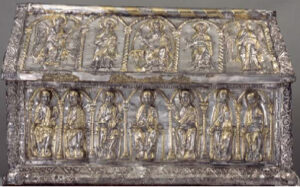 The shrine was made to hold the remains of St. Sigismund and his children in the workshop of the Abbey around 1100. On one gable-end is the famous depiction of St. Maurice. On the other end, the kings – Sigismund, Gundobald, and Giscald are seated.
The shrine was made to hold the remains of St. Sigismund and his children in the workshop of the Abbey around 1100. On one gable-end is the famous depiction of St. Maurice. On the other end, the kings – Sigismund, Gundobald, and Giscald are seated.
The Shrine of Nantelme

In 1225, the abbot at Saint-Maurice d’Agaune commissioned a shrine to hold the remains of the saint. This shrine is less flashy, formed as an elongated house with a simple row. The decoration consists of engraved scenes framed by bands of foliage. On one side of the roof, the saint is enthroned between Sigismund and Gundobald, who is depicted next to Giscald. On the other side is a scene of the crucifixion. At the gable ends, the three magi visits the enthroned Virgin, while Christ is blessing the world on the opposite side.
The Shrine of St. Maurice
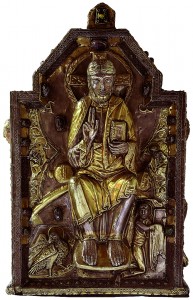 This shrine was fashioned out of pieces stemming from a golden antepedium. The altar frontal originally showed Christ, two angels, all the apostles plus two donors. Some of these pieces were reassembled as a shrine between the 13th and 15th centuries.
This shrine was fashioned out of pieces stemming from a golden antepedium. The altar frontal originally showed Christ, two angels, all the apostles plus two donors. Some of these pieces were reassembled as a shrine between the 13th and 15th centuries.
The head reliquary of St. Candide.
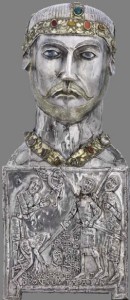 Also made in the workshop at Saint-Maurice d’Agaune around 1165, the head reliquary of Candidus portrays the saint in the round, as well as on the base, in relief.
Also made in the workshop at Saint-Maurice d’Agaune around 1165, the head reliquary of Candidus portrays the saint in the round, as well as on the base, in relief.
READ MORE:
Catalogue: Le Trésor de l’abbaye de Saint-Maurice d’Agaune
By Élisabeth Antoine-König (ed)
Louvre et Somogy 2014
ISBN French 978-2-75720-781-9
ISBN German 978-2-75720-800-7
